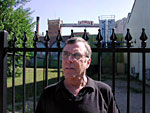By Mary Losure
Minnesota Public Radio
September 23, 2002
The Environmental Protection Agency is negotiating with ethanol plants across the nation to cut back air pollution. Testing at Gopher State Ethanol, a converted St. Paul brewery, showed levels of pollutants far higher than the industry had claimed. Those results triggered an EPA crackdown on ethanol plants nationwide.
| |
|
|
|
||
The castle-like brick building of the old Schmitz Brewery towers over the surrounding houses on the flats of the Mississippi River. For generations, neighbors coexisted peacefully with the smell of beer-making. But in April 2000, the financially troubled brewery -- now called the Minnesota Brewing Company -- began making a new product: ethanol.
Darren Wolfson, who lives five blocks away, noticed the change in the air immediately. "The second they flipped the switch, it was like a smack in the face, he says.
Emissions from the plant's 200-foot-tall stack soon began drifting into gardens of the stately homes in St. Paul's Crocus Hill neighborhood, which overlooks the river flats.
Resident Andy Driscoll says he was flooded with the odor, which he describes "rubbing alcohol mixed with burning corn."
Prodded by hundreds of complaints, the Minnesota Pollution Control Agency began testing emissions from the plant. They found high levels of carbon monoxide, as well as what are known as Volatile Organic Compounds or VOCs. VOCs included formaldehyde and acetaldehyde, both of which are known to cause cancer in animals.
The vast majority of the nation's ethanol plants are located in rural countryside outside small towns and cities. There, they have not generated anything like the outcry heard in St. Paul. But given the test results at Gopher State, the EPA began sampling emissions of rural plants as well, and found problems just as severe.
The EPA concluded that "most if not all" ethanol plants are emitting air pollutants at many times the rate allowed by their permits.
The EPA's Midwest regional administrator, Tom Skinner, says the agency is now negotiating with the industry over emission control technologies, which he says in the case of ethanol are relatively straightforward.
"There are devices called thermal oxidizers that in essence burn up the emissions on their way out of the plant," he says. "They are not inexpensive, the units range approximately in the $1 million range, but in terms of the overall facility it's not an unreasonable expense. And it does solve the problem."
| |
|
|
|
||
The negotiations come as the ethanol industry is poised for a major expansion. The EPA sent a letter this spring to industry representatives from Minnesota and other Midwest states. The letter suggested rather than having the EPA going through traditional enforcement channels with each individual plant, the group negotiate as a whole to resolve the problem.
"We feel that this approach can give certainty to the industry by quickly addressing both state and federal concerns and resolving them on terms most favorable to the industry," the letter says.
Representatives of the Minnesota ethanol industry declined to comment on the negotiations. Monte Shaw of the Renewable Fuels Association, the ethanol industry's national trade group, says thermal oxidizers are highly effective. But he says the plants are also considering other pollution control technologies which may be less expensive.
"Instead of having a thermal oxidizer, which you kind of take the air of the stack and burn it separately, I think there are some plants across the country that will simply look at routing the dryer stack air through their boiler process," he says. "That's something that will have to be tested and if it works, that will be an option."
In St. Paul, where Gopher State Ethanol installed a $1.2 million thermal oxidizer, results have been mixed. Neighborhood residents continue to complain of odors and ill health effects. "It seems to knock out some of the most noxious of the odors," says Darren Wolfson. "There's no question that it's helped, when it's on and working, but it doesn't help enough. There are other problems at the plant."
A report by the State Health Department found that the source of much of the remaining problem may be so- called "fugitive emissions" from vents and leaking pipes not affected by the oxidizer. The oxidizer broke down last month, compounding the neighborhood's problems and leading to a new flood of complaints.
More Information

